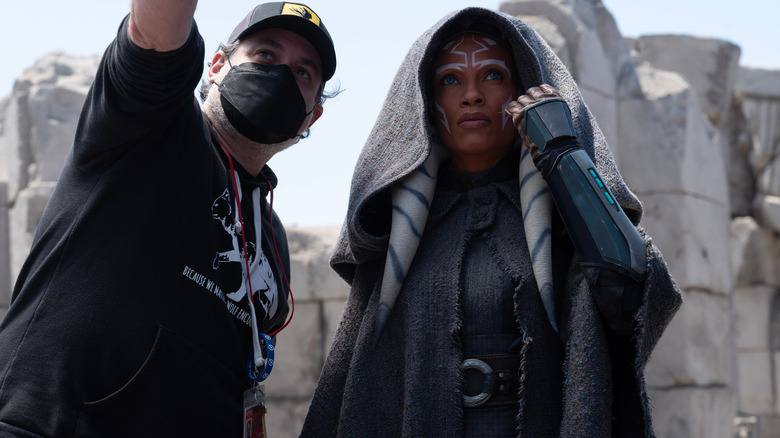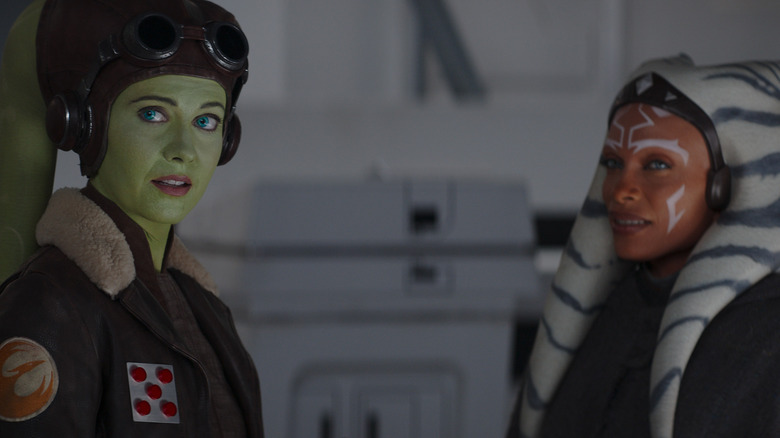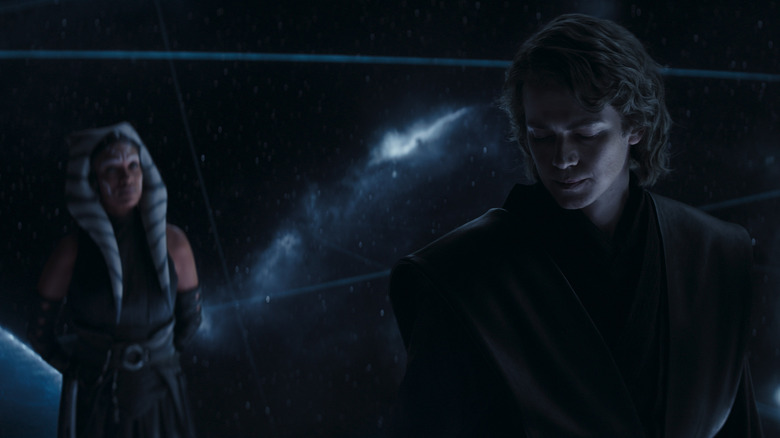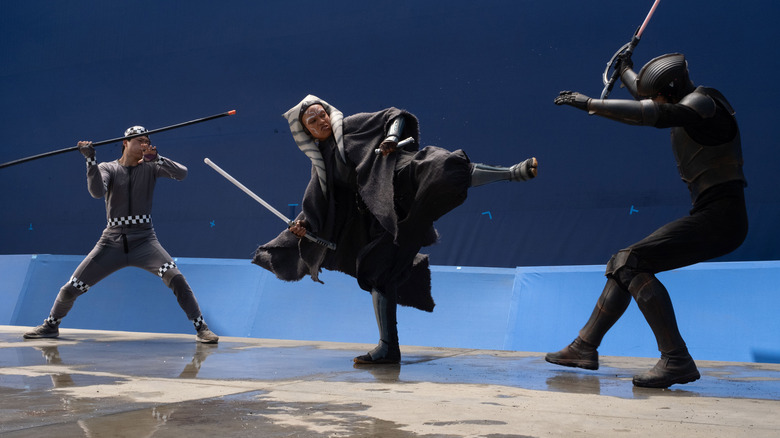The Biggest Problem With Ahsoka? It Should Never Have Been Live Action
Warning: This article discusses major spoilers for the "Ahsoka" season 1 finale.
Even as far back as when "Ahsoka" was first announced and it became more and more apparent that this new show would act as a sequel to "Star Wars Rebels," I've had one obvious question burning at the forefront of my mind: Why make this into a live-action series, rather than another animated one? After all, fans first fell head-over-heels in love with heroes like Ahsoka, Ezra, Sabine, Hera, and Kanan (and poor, forgotten Zeb) because of their distinctive and wonderfully expressive character designs, their pitch-perfect voice actors, and the grand adventures they experienced together within a medium that allowed for endless amounts of creativity and imagination. To strip such core traits away from these Rebels, recast (most of) them with a bunch of lookalikes, and drop them in unfamiliar and jarring live-action environments is to misunderstand what made them so appealing in the first place.
Surely franchise guru, heir apparent to George Lucas himself, and creator/writer of "Ahsoka" Dave Filoni couldn't be accused of a sin as grave as that ... right?
Unfortunately, if "Ahsoka" taught us anything, it's that even the most well-intentioned of us can still lose our way. For Ahsoka (Rosario Dawson) and Sabine (Natasha Liu Bordizzo) in the early going, fear of failure and of repeating past mistakes paralyzes both characters, despite all their successes and accomplishments over the years. So maybe there's a weird sense of poetry to the idea that, despite crafting the definitive "Star Wars" animated shows that redeemed the maligned prequel trilogy in the eyes of many, even Filoni may have succumbed to temptation. By chasing the allure of officially "canonizing" the animated universe into live action, "Ahsoka" ultimately let down its own characters — and their fans.
Sorry, do I know you?
Anyone with the misfortune of attending a high school reunion or even just bumping into an old acquaintance that you lost contact with long ago can speak to the awkwardness of attempting to pick up where you once left off. In the early episodes of "Ahsoka," the scripts devote quite a lot of screen time to acknowledging the long years that have past since we last saw these characters and establishing their post-"Rebels" status quo since the gang went their separate ways. But as much as their starting points make logical sense — Sabine is now a loner and a recluse on Lothal after having lost Ezra (Eman Esfandi), Hera (Mary Elizabeth Winstead) has been promoted to the rank of general within the fledgling New Republic, and Ahsoka has prioritized her quest to locate Grand Admiral Thrawn over everything else — there still remains a glaring emotional disconnect.
Whether you chalk it up to Filoni's inexperience directing actors in live action, the casting choices themselves, or the actual writing (or all the above), it's hard to dispute the notion that very few of these characters in "Ahsoka" seem like convincing translations of the versions we became familiar with throughout "Rebels." It's one thing for Dawson to constantly fold her arms exactly as Ahsoka once did, or Winstead to call out to Hera's droid Chopper in the middle of an aerial dogfight, or Esfandi to channel Ezra's patented stormtrooper voice impersonation. It's quite another to move beyond surface-level pantomimes and frustratingly low-energy performances to faithfully evoke the personalities, screen presence, and souls of the characters we previously came to love.
Instead, making "Ahsoka" a live-action series put the burden entirely on viewers to accept that, apparently, all that matters in casting are looks and impressions alone.
Unhappy reunions
As disappointing as it is to allow the tail to wag the dog with regards to casting choices in "Ahsoka" (the popular fan-cast of Rosario Dawson, for instance, only really gained steam because the actor was the one recognizable name to franchise devotees who vaguely looked like Ahsoka and sounded somewhat reminiscent of original voice actor Ashley Eckstein's portrayal), the ripple effects extend far beyond mere casting alone.
Take, for instance, the fact that much of "Ahsoka" consists of little more than long-lost characters reuniting with one another. Filoni and his fellow directors on the series do their best to make each of these moments hit as hard as possible, whether it be Ahsoka and Sabine's tense interactions in the premiere or Sabine and Ezra finally coming face to face again in another galaxy entirely, but something vital can't help but feel lost in translation. In episode 5, much is made of the fact that Ahsoka and her old master Anakin find one another again in the World Between Worlds. But there's just one problem: Despite being treated like a moment years in the making, this was the very first time actors Rosario Dawson and Hayden Christensen had ever shared a scene together in this franchise. For viewers like me, the sizable gap between Ekstein and Anakin voice actor Matt Lanter's portrayals of their respective characters in "Rebels" versus Dawson and Christensen's was simply too far to bridge emotionally. There's suspension of disbelief ... and then there's requiring viewers to bring in all kinds of outside baggage (i.e. our nostalgia for seeing Christensen on-screen again) to do the heavy-lifting to make such moments feel important.
You know what would've been even more meaningful? Seeing this reunion take place in an animated "Ahsoka" series with their original voice actors.
Shooting itself in the foot
Worst of all, however, is the fact that the powers that be willingly constrained "Ahsoka" to the limits of a live-action series, despite Dave Filoni's unquestionable expertise in the field of animation. A large part of the success of both "The Clone Wars" and "Rebels" came from the fact that the medium gave his creative team free rein to fully realize the scope and scale of the galactic conflicts of their era, in a way that — dare I say it — rivaled even George Lucas' mega-budget blockbusters. Not only did fans of the shows get to experience a front-row seat to the Clone Wars like never before, but the freedom of animation provided plenty of leeway for some of the most out-there concepts imaginable, like mind-control worms infecting clones and magical Dathomiri witches spewing green-colored spells and giant monsters attacking planets.
Yet, in "Ahsoka," the self-imposed limitations of live-action either manifested as bizarrely un-engaging fight sequences and action scenes set against distractingly fake-looking CGI environments (those purposefully fog-heavy visions of Ahsoka and Anakin fighting in the Clone Wars should never have brought to mind a certain AI-generated meme) or the utter lack of important characters like Zeb (voiced by Steve Blum), whose expensive, all-VFX design likely forced him to be written out of the action for eight full episodes.
In the end, I'm not convinced the benefits of shoehorning "Ahsoka" into a live-action series even come close to outweighing all the disadvantages. Yes, it's increasingly clear that Filoni is driven by the need to officially 'canonize' his animated additions to "Star Wars," but nobody worth taking seriously believes that animation is inherently inferior. "Ahsoka" had all the potential of living up to the high standards set by "Rebels" ... if only it were animated.



